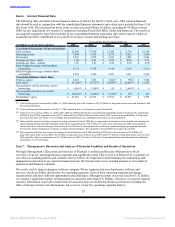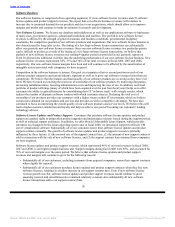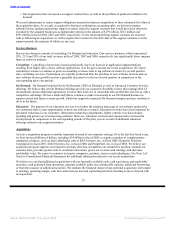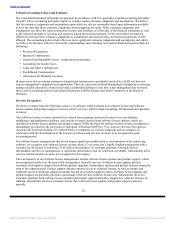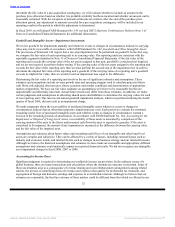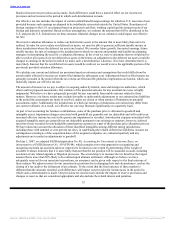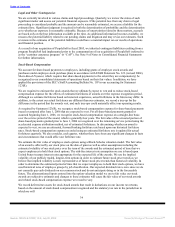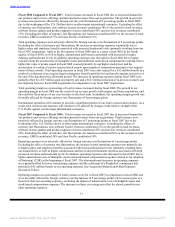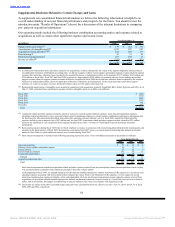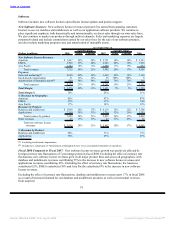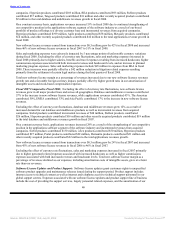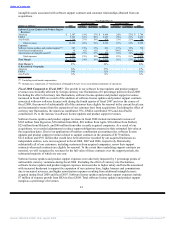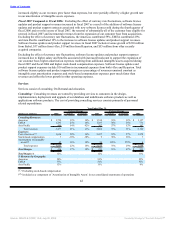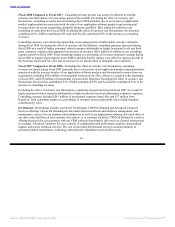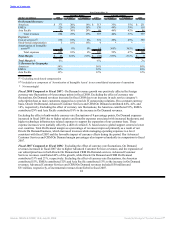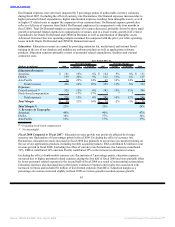Oracle 2007 Annual Report Download - page 40
Download and view the complete annual report
Please find page 40 of the 2007 Oracle annual report below. You can navigate through the pages in the report by either clicking on the pages listed below, or by using the keyword search tool below to find specific information within the annual report.
Table of Contents
receive a tax deduction. Because the deferred tax assets we record are based upon the stock-based
compensation expenses in a particular jurisdiction, the aforementioned inputs that affect the fair value of our
stock awards also indirectly affect our income tax expense. In addition, differences between the deferred tax
assets recognized for financial reporting purposes and the actual tax deduction reported on our income tax
returns are recorded in additional paid-in capital. If the tax deduction is less than the deferred tax asset, such
shortfalls reduce our pool of excess tax benefits. If the pool of excess tax benefits is reduced to zero, then
subsequent shortfalls would increase our income tax expense. Our pool of excess tax benefits is computed in
accordance with the alternative transition method as prescribed under FASB Staff Position FAS 123R-3,
Transition Election to Accounting for the Tax Effects of Share-Based Payment Awards.
To the extent we change the terms of our employee stock-based compensation programs or refine different
assumptions in future periods such as forfeiture rates that differ from our estimates, the stock-based
compensation expense that we record in future periods and the tax benefits that we realize may differ
significantly from what we have recorded in previous reporting periods.
Allowances for Doubtful Accounts
We make judgments as to our ability to collect outstanding receivables and provide allowances for the portion
of receivables when collection becomes doubtful. Provisions are made based upon a specific review of all
significant outstanding invoices. For those invoices not specifically reviewed, provisions are provided at
differing rates, based upon the age of the receivable, the collection history associated with the geographic
region that the receivable was recorded and current economic trends. If the historical data we use to calculate
the allowances for doubtful accounts does not reflect the future ability to collect outstanding receivables,
additional provisions for doubtful accounts may be needed and our future results of operations could be
materially affected.
Results of Operations
The comparability of our operating results in fiscal 2008 compared to fiscal 2007 is primarily impacted by our
acquisition of Hyperion in our fourth quarter of fiscal 2007, our acquisition of Agile Software, Inc. in our first
quarter of fiscal 2008 and our acquisition of BEA in our fourth quarter of fiscal 2008.
The comparability of our operating results in fiscal 2007 in comparison to fiscal 2006 is impacted by our
acquisition of Siebel in our third quarter of fiscal 2006, the consolidation of i-flex solutions limited at the
beginning of fiscal 2007 and, to a lesser extent, our acquisition of Hyperion in our fourth quarter of fiscal
2007.
In our discussion of changes in our results of operations from fiscal 2008 compared to fiscal 2007, and fiscal
2007 compared to fiscal 2006, we quantify the contribution of our acquired products to the growth in new
software license revenues, the amount of revenues associated with software license updates and product
support, as well as On Demand services (in the fiscal 2007 to fiscal 2006 comparison), and present
supplemental disclosure related to certain charges and gains (including acquisition accounting and
stock-based compensation), where applicable. Although certain revenue contributions from our acquisitions
are quantifiable, we are unable to identify the following:
• The contribution of the significant majority of consulting and education services revenues from
acquired companies in fiscal 2008, 2007 and 2006 (with the exception of the impact of BEA consulting
and education revenues in fiscal 2008 in comparison to fiscal 2007, and i-flex and Hyperion consulting
revenues and Hyperion education revenues for which we disclose the impact in fiscal 2007 in
comparison to fiscal 2006) as the significant majority of these services have been fully integrated into
our existing operations.
• The contribution of expenses associated with acquired products and services in fiscal 2008, 2007 and
2006 (with the exception of the impact of certain BEA operating expenses in fiscal 2008 in comparison
to fiscal 2007 and the impact of certain i-flex and Hyperion operating expenses for which we disclose
the impact in fiscal 2007 in comparison to fiscal 2006) as the significant majority of these services
have been fully integrated into our existing operations.
35
Source: ORACLE CORP, 10-K, July 02, 2008 Powered by Morningstar® Document Research℠


